Baked Loaded Mashed Potato Casserole
Loaded Mashed Potato Casserole is the most delicious way to repurpose up to 4 cups of leftover mashed potatoes. It’s loaded with bacon, cheese, sour cream and two kinds of onion, and topped with cheese crackers for good measure.
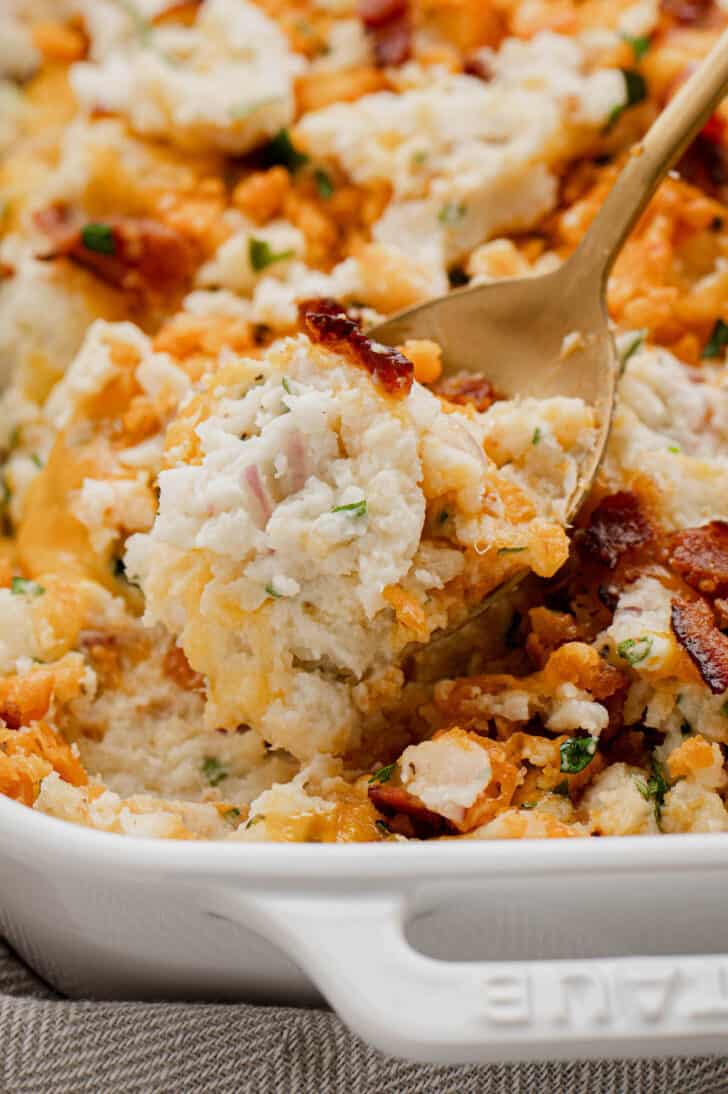
“This recipe is a winner! Easy to improvise if needed. I made it yesterday and it turned out to be melt in your mouth, delicious and memorable. Absolutely perfect way to use up leftovers!”
—Melinda
“Made this on Sunday before Christmas for our family Christmas meal. This was a huge hit! This recipe is now added to my favorites recipes.”
—Debra
“This is KILLER GOOD!! Took to a football party as a side. I felt bad… my dish went before the main one and other sides!!!”
—Patty
Ever Wonder Wha To Make With Leftover Mashed Potatoes? Here Is The Answer!
Thanksgiving is one of my favorite holidays, but with a gathering of just five people, we’re often stuck with quite a bit of leftovers after the big meal.
While you can simply reheat leftover mashed potatoes and drizzle them with gravy from scratch a second time around, my favorite way to serve leftover mashed potatoes is this Loaded Mashed Potato Casserole.
Make this, and you’ll use up 4 cups of mashed potatoes, so this might be the only leftover recipe you need (or, you can easily make a half batch of this if you have less leftovers).
It’s loaded with all the good stuff, like bacon, cheese, sour cream and two kinds of onions, and topped with crushed cheese crackers for good measure.
Why You Will Love These Leftover Mashed Potatoes
- Revive leftover mashed potatoes (that tend to get a bit dry) by adding lots of moisture and flavor!
- This casserole is very adaptable to your family’s preferences and whatever ingredients you happen to have on hand. Omit the bacon for a vegetarian dish, or use different herbs, cheese, etc.
- Delicious enough to take to a Friendsgiving get-together!
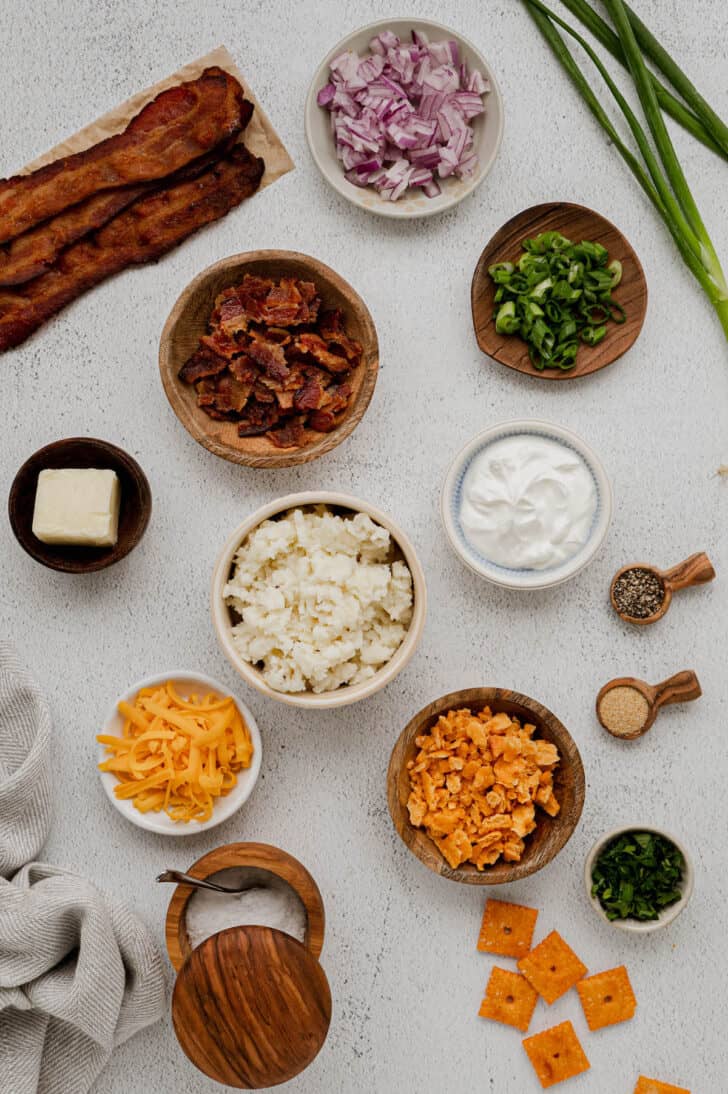
Mashed Potato Casserole Ingredients
- mashed potatoes – use whatever type of mashed potatoes you have on hand for this leftover mashed potato recipe. I usually make a double batch of mashed potatoes with heavy whipping cream for Thanksgiving, and use the leftovers here.
- sour cream – this adds some moisture back into the mashed potatoes, which tend to dry out when they’re heated up a second time.
- garlic powder – I normally use fresh garlic for just about everything, but I actually love the flavor of garlic powder in mashed potatoes!
- sharp cheddar cheese – because it’s not a loaded mashed potatoes recipe unless we add cheese! You can use any type of cheese you want.
- bacon – make a quick batch of bacon in the oven, or cook bacon in air fryer and crumble it up. Or, if turkey bacon is more your speed, check out my tutorials on how to cook turkey bacon in oven and turkey bacon in the air fryer!
- red onion – I add quite a bit of onion to this loaded mashed potato casserole for added flavor. You can also use white or yellow onion.
- green onion – yes, a second type of onion! I like to add these for color.
- parsley – this is mainly for color, but you can skip it if you don’t have any on hand.
- cheese crackers – I love adding crushed cheese crackers (like Cheez-Its or Goldfish) to the top of these baked loaded mashed potatoes for a bit of crunch. You can also use Ritz crackers or potato chips!
- butter – tossing the crackers in a bit of melted butter ensures they’ll get nice and golden brown on top of the casserole.
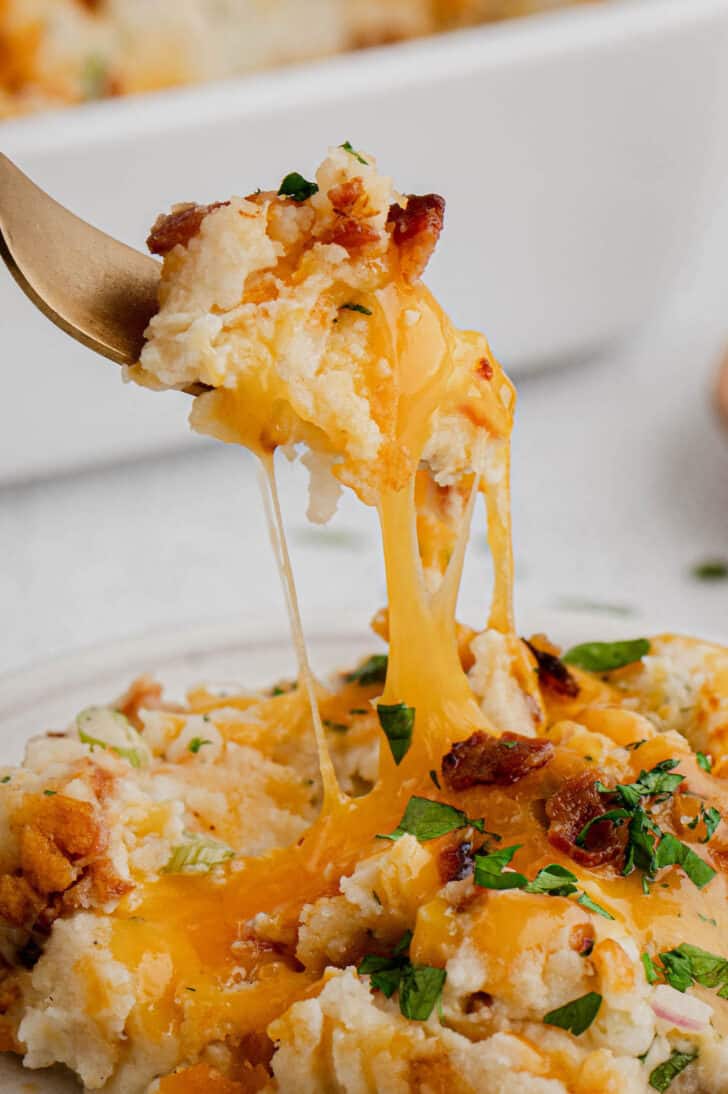
What Are The Top 3 Potatoes For Mashed Potatoes?
For ideal taste and texture, the best potatoes for mashed potatoes are Russet (my top choice), Idaho or Yukon Gold potatoes. The creamy and starchy consistency of these types of potatoes makes the smoothest, most velvety mashed potatoes.
How To Make Loaded Mashed Potato Casserole
1. PREP. Preheat the oven, spray a casserole dish with nonstick spray, and stir together the cheese crackers and melted butter to make the topping.
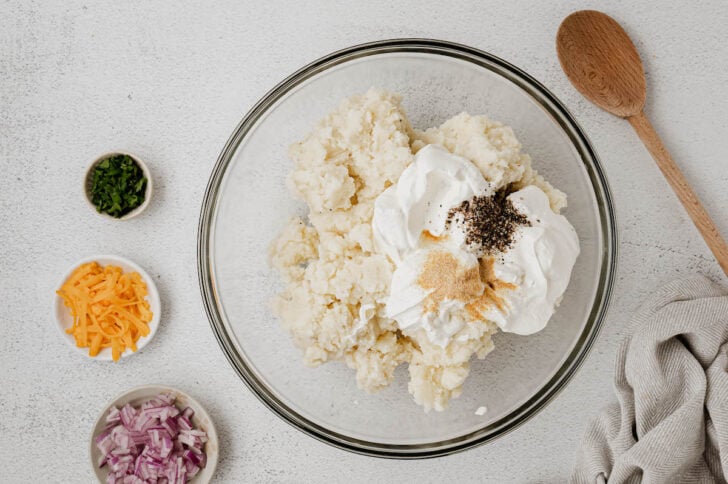
2. WARM AND MIX POTATOES. If your mashed potatoes are cold, microwave them briefly until they are just soft enough to stir again. Stir the sour cream, garlic powder and pepper into the mashed potatoes.
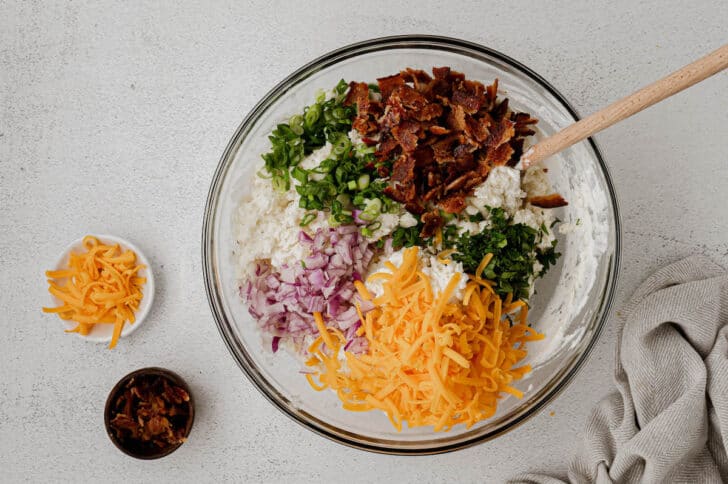
3. ADD THE MIX INS. Set aside 2 tablespoons each of bacon and cheese, then add the rest of the bacon and cheese, along with the red onion, green onion and parsley to the potatoes. Stir until everything is well combined.
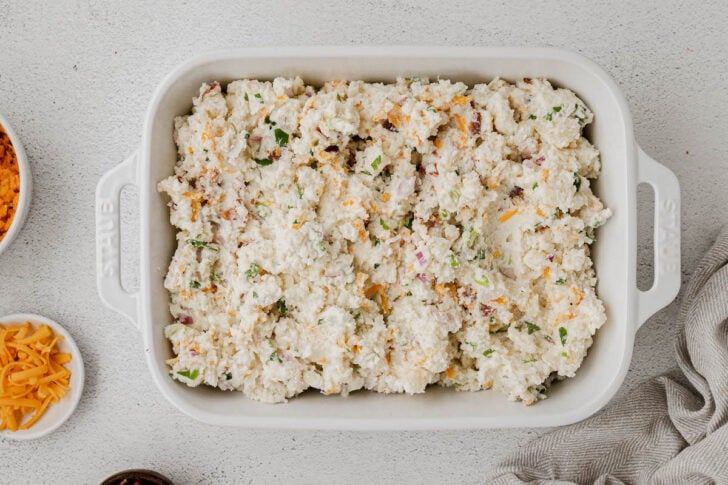
4. CASSEROLE DISH. Transfer the potato mixture to the prepared baking dish and spread it into an even layer.
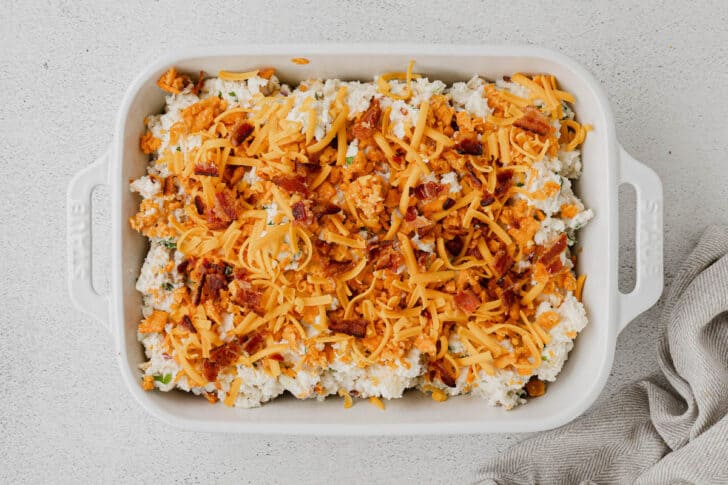
5. TOPPINGS. Sprinkle the potato mixture with the cracker mixture and the reserved bacon and cheese.
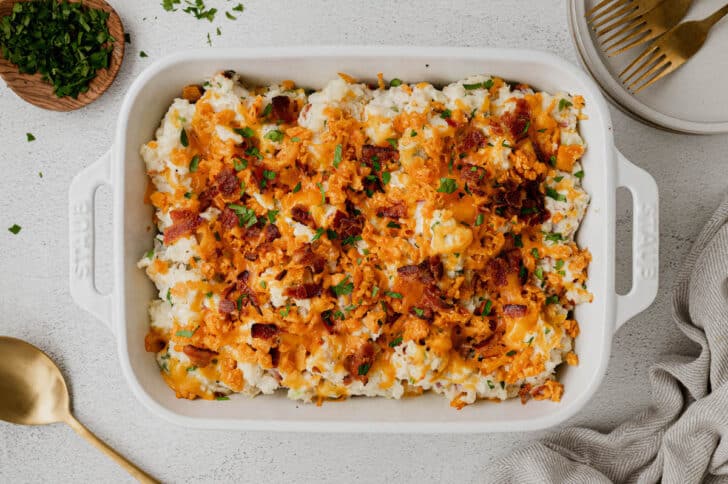
6. BAKE. Transfer the dish to the oven and bake 25 to 30 minutes or until everything is heated through.

How To Serve Mashed Potato Casserole
Serve this luscious casserole as a satisfying side dish to a main course any time of the year, or serve it alongside leftovers of your holiday entree. Some ideas include:
Save This Recipe!
Home Chef Tips For Loaded Mashed Potatoes
- This recipe works great with leftover mashed potatoes, but you can also make it starting with fresh mashed potatoes (make mashed potatoes specifically in order to make this recipe).
- If using leftover mashed potatoes, the potatoes do need to be slightly warmed (use the microwave) before stirring in the other ingredients. Cold mashed potatoes are very hard to stir and incorporate with the other ingredients.

How To Store Loaded Potato Casserole
If you make this mashed potato casserole with freshly-made mashed potatoes, you can cool any leftovers and then store them in an airtight container in the fridge for up to 3 days, or the freezer for up to 3 months.
However, if you make these loaded mashed potatoes using leftover mashed potatoes, I do NOT advise keeping them and reheating them again.
As a general rule of thumb for food safety, you only want to reheat leftovers once. Anything left over after that, you should discard.
How To Reheat Mashed Potatoes
The easiest way to reheat leftover, plain mashed potatoes is to simply spread them in a buttered casserole dish, cover them with foil, and bake at 350 degrees F until they are completely heated through.
But why not add some extra flavor before you reheat? That’s where this loaded mashed potato casserole recipe comes in, allowing you to add a bunch of flavorful mix-ins before you reheat.
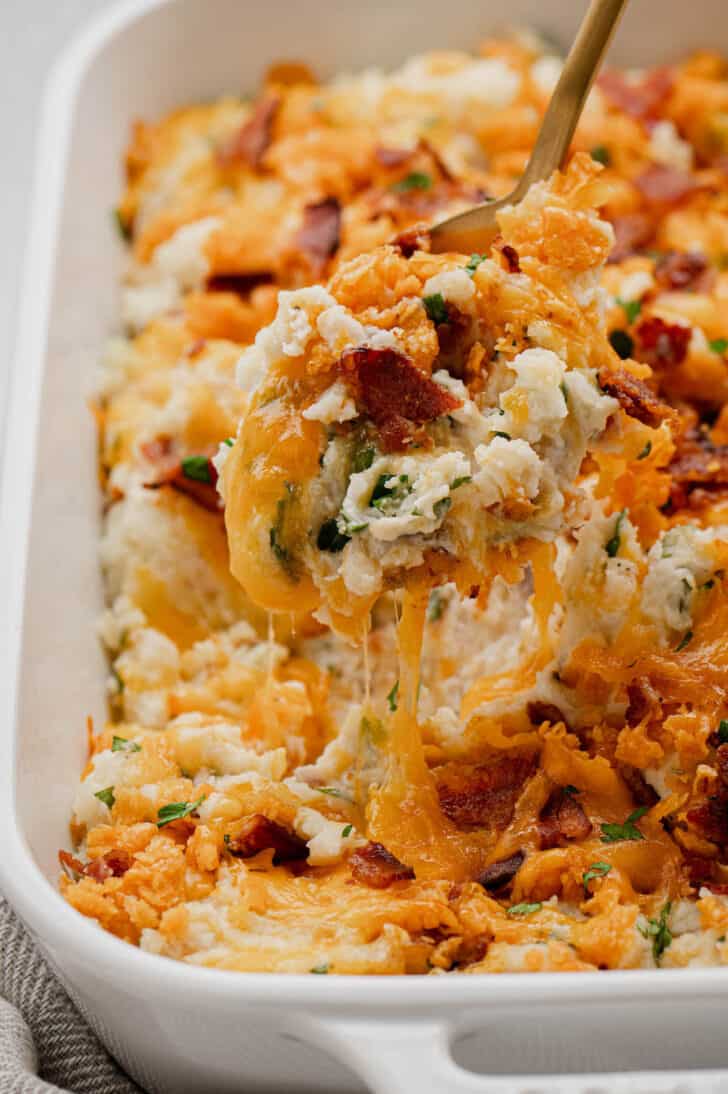
Loaded Mashed Potatoes Recipe FAQs
Some people believe that baking potatoes enhances their natural sweetness and gives mashed potatoes a richer flavor profile, but I’ve always made them with boiling water on the stove, and they turn out delicious.
Incorporating butter first would coat the starch molecules of the potato, preventing them from absorbing too much liquid. But, I’ve found that if you use the correct ratio of potato to dairy, this isn’t necessary. I add it all at one time, and again, they turn out delicious!

More Foxes Love Lemons Favorites

Loaded Potato Casserole
Save This Recipe!
Ingredients
- Nonstick cooking spray
- ½ cup coarsely crushed cheese crackers
- 2 tablespoons unsalted butter melted
- 4 cups mashed potatoes
- ½ cup sour cream
- ½ teaspoon garlic powder
- ½ teaspoon ground black pepper
- 6 slices oven baked bacon crumbled
- 8 ounces shredded sharp cheddar cheese
- ½ cup finely chopped red onion
- 3 tablespoons thinly sliced green onion or chives
- 2 tablespoons chopped fresh parsley
Instructions
- Preheat oven to 350 degrees F. Spray large casserole dish with nonstick spray. In small bowl, stir crackers and butter until well combined.
- If mashed potatoes are cold, place in a large microwave-safe bowl and microwave 60 to 90 seconds to soften. Add sour cream, garlic powder and pepper to potatoes; stir until well combined.
- Reserve 2 tablespoons each bacon and cheese. Add remaining bacon and cheese to potatoes, along with red onion, green onion and parsley; stir until well combined.
- Transfer mixture to prepared casserole dish and sprinkle with cracker mixture and reserved bacon and cheese. Bake 25 to 30 minutes or until heated through.
Video
Notes
- Home Chef Tip: Casserole can be assembled up to 2 days before baking. Wrap tightly and refrigerate after assembly. To bake, uncover and allow casserole to come to room temperature for 30 minutes before baking as directed (you may need to add a few minutes to the baking time).


Made this on Sunday before Christmas for our family Christmas meal. I made the mashed potatoes the day before and finished the casserole the day of the meal. I riced the potatoes to give them a smoother and creamier consistency. I, also, left out the fresh parsley. This was a huge hit! This recipe is now added to my favorites recipes.
I’m so glad this recipe could be a delicious part of your Christmas celebration, Debra. Happy New Year!
This is KILLER GOOD!! Took to a football party as a side. So started from scratch. I had read that a person liked the potatoes baked and then peeled instead of traditional stovetop water. I cooked idaho’s in the mico till fork tender( turned once.). I also added a little more cream cheese, and onions. These taters were a little more dry so used 1/2 &1/2. Eyeball that. Less watery doing the taters this way, but more tasty! All other things , same as recipt. After baking as directed, i did sprinkle more very fine scallions. I felt bad… my dish went before the main one and other sides!!!will ALWAYS MAKE THIS SIDE WHEN EVER NEEDED!!!
I’m so glad you like this so much, Patty! It’s so perfect for a football party.
May I put this all together the day before and then bake it??
Absolutely! Just keep it covered in the fridge, and bring to room temp one hour before baking.
This recipient is a winner! Easy to improvise if needed.. I made it yesterday and it turned out to be melt in.your mouth, delicious and memorable.
For me I used chicken broth vs. water in the potatoes when I made them earlier.. And instead of sour cream (which I used for this recipe previously) I used half heavy cream and half whole milk. To reheat the potatoes prior to cooking (excellent suggestion!) I moistened them with a tad heavy cream.
Absolutely perfect way to use up leftovers!
Love to hear a recipe is memorable, Melinda. That’s exactly what I’m going for. Thank you for stopping by to let me know.
Great recipe! We had lots of left over mashed potatoes when our family was here for “Thanksgiving in July” I found this recipe while looking for what to do with all the leftovers.
The only think I changed was using Ritz crackers on top since I didn’t have any other the others.
We will make this again for sure!
I’m so glad to hear you liked this, Cherilyn. I use Ritz crackers for this all the time, too.
What can be used in a pinch for the cheese crackers?
Do you have potato chips?